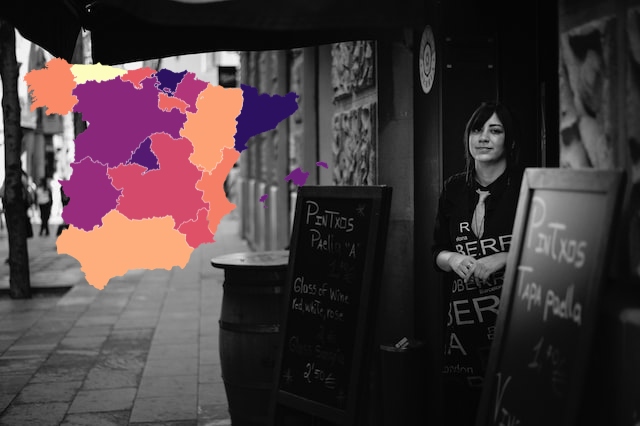Spain’s much-loved menús del día (menus of the day) are sacred to many Spaniards and can be found in pretty much every city, town and village across the country.
They are typically three-course menus served at lunchtime for a fixed price and include a drink, which may be beer or wine, as well as bread.
READ ALSO – The secrets of El Menú del Día: The surprising story behind Spain’s fixed-price lunch menu
The menús del día date back to the 1960s during the Franco regime, when they were called menús túristicos and were introduced so that tourists would be able to pay a fixed price to enjoy Spanish cuisine.
In the 1970s, they changed their name to menús del día as they became even more popular with the local population. In most cases, you can select between several dishes for each course and depending on what you order, menús del día can be great value for money.
Between 3 and 4 million people regularly enjoy the menú del día offer in Spain.
Inflation on the menu
But like a lot of the world in 2022, Spain has been gripped by a cost-of-living crisis and it now seems that the much-loved menú del día is becoming the latest victim of inflation.
According to a survey conducted by Hostelería de España, between November 2021 and April 2022, four in ten restaurants in Spain have put up the price of their daily menu offer by 5 percent, a third have raised it by 10 percent, and 7 percent of restaurants raised the prices by 15 percent.
In cash terms, a 5 percent increase is roughly 70 cents, a 10 percent rise is around €1.40, and restaurants that have raised the price by 15 percent have put up prices by around €2.
READ MORE: Huge debate roars over vague hint that ‘menús del día’ should drop beer and wine
According to the survey, the average price of the menú del día across Spain is now around €12.80.
The hospitality sector in Spain, though enjoying the return of post-pandemic tourism, is struggling to cope with the surge in energy prices and raw materials.
Spain’s National Institute of Statistics, the INE, reported in mid-July that the country’s 10.2 inflation rate was the highest level the country had experienced since 1985.
For many restaurants and bars, simply paying the gas and electricity bills or buying basic food stuffs have become an existential cost. As a result, many have decided – or been forced – to raise their prices, and the affordable menú del día is no exception.
The menú del día cost a little over €4 on average 20 years ago, around 700 pesetas. Nowadays, fixed menus can range from €8 to €14.
Most expensive menús del día in Spain in 2022
But where are the most expensive cities in Spain for a menú del día?
It is worth noting that the following figures are very much focused on major cities, and are not reflective of prices in smaller towns and villages. Often, it will be possible to find much more affordable menú del día offers in small-town bars and restaurants, although even there the inflationary pressures have likely passed on price increases to the customer.
According to the figures from Hostelería de España, Barcelona is the priciest place in Spain, with an average price of €14. Not far behind in second place is Madrid, where the average price is now €13.90.
Coming in third is Palma de Mallorca, where the price has risen to €13.60 on average, and Bilbao comes in at fourth, with an average menú del día price of €13.50.
Rather surprisingly compared to the cost of living in Murcia more generally, the average price in the southern region has risen to €13, and Zaragoza is shortly behind at €12.80, with Valencia at €12.60.
As is often the case in Spain, the further south you go the cheaper things get. In Andalusia, a menú del día now costs €12.50 on average in Málaga, and €12 in Seville.
Las Palmas de Gran Canaria in the Canary Islands reportedly has the cheapest menú del día at an average price of €11.50, although it’s worth noting that this data only encompasses Spain’s ten most populous cities (More on regional menú del día data further down).
Here is a breakdown of the average menú de día price in 2022 in Spain’s biggest cities:
- Barcelona €14
- Madrid €13.90
- Palma de Mallorca €13.60
- Bilbao €13.50
- Murcia €13
- Zaragoza €12.80
- Valencia €12.60
- Malaga €12.50
- Sevilla €12
- Las Palmas de Gran Canaria €11.50
Hostelería de España has also collected data on what the average price of the menu del día is across Spain’s regions.
We’ve compiled their data into the following map, and below that you’ll find a breakdown of how much menú del día prices have increased across Spain’s regions from 2016 to 2022.
Price increase of the ménu del día across Spain's regions from 2016 to 2022
Galicia: +16.4 percent
La Rioja: +15.7 percent
Basque Country: +12.5 percent
Extremadura: +11.3 percent
Catalonia: +10.8 percent
Madrid: +10.4 percent
Asturias: +9.8 percent
Andalusia: +9.7 percent
Cantabria: +9.6 percent
Castilla y León: +9.1 percent
Aragón: +8.8 percent
Valencia region: +8.3 percent
Navarre: +6.5 percent
Balearic Islands: +4.6 percent
Castilla-La Mancha: +4.4 percent
Canary Islands: +2.7 percent
Murcia: +1.6 percent



 Please whitelist us to continue reading.
Please whitelist us to continue reading.
Member comments